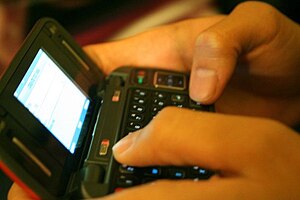They were advising me that since I subscribed to their home phone service, and digital TV service, that I was receiving a new service completely free – TV Call Waiting.
This new service will display a person’s name and number on my TV screen, as well as on my phones. The feature even allows me to send the call directly to voice-mail simply by hitting a button on my remote control.
Pretty cool tool. It could be annoying, especially if you are glued to the couch watching your favorite shows, but there still is an element of “wow” to this new technological development.
Whether you love it or hate it, the real “wow” factor comes from a little forward-looking thinking. Back in the 1990’s, there was all this talk about the convergence of communications technologies.
The first big convergence brought on by technology was the Internet and the mass media. Television, radio and newspapers were the most popular forms people around the world got their information. As the Internet developed, it became possible to watch live streaming video online, listen to live streaming audio and even to read complete newspapers online – with hyperlinks for additional information. This became known as the media convergence, and many say it sparked a death sen
 Image via Wikipedia
Image via Wikipedia
Convergence was the buzz word given to discuss the morphing of television, radio, home theatre systems, phone systems, even your kitchen appliances with computers. Futurists dreamt allowed about a world where you could call home from work, turn on the oven to start your pot roast remotely while checking your messages. Then later that day, you’d arrive home with a nice hot pot roast just waiting for you.
We’ve seen the greatest form of convergence in the mobile telecommunications market. The first cell phones were huge clunkers that often didn’t even have a signal, because cell phone technology was so new and expensive. These days, cell phones are teeny-tiny, and do more than act as phones. Most have cameras in them, some allow you to play music, others allow you to surf the net, send video messages, open Word and other MS-Office documents, you even can use a built-in GPS to tell you where you are, and how to get to where you want to be.
Smart home technology has improved over the years, but it is far from the wild dreams of the futurists back in the 1990’s. But with small technological first-steps, like my telco’s TV Call Display, we’re slowly but steadily moving closer to that automated world.
I’ve had digital cable for years, and as long as I’ve been a subscriber, you can order movies onDemand or Pay-Per-View with a click of a button. Simple point and click, and the movie begins, while the charges appear on my next cable bill.
This two-way form of communications over a cable TV connection was never possible under the older analogue system, and it opens up a whole new world of possibilities.
One day, you will be able to order products the same way you can order movies – just by pressing a button on your remote control. Imagine watching some infomercial late at night, and seeing a fantastic product that you want right then and there. All you have to do is point your remote at the cable box, click the button to order it, confirm your order by entering your PIN code, and wait for your new fangled thing to arrive in the mail.
Other cool “wow” factor technologies which we may see from these developments include – of all things – home security.
Many people have wireless home security cameras in and around their homes, and can view these cameras from anywhere in the world over the Internet. There was one incident just this past summer, where a lady called police from work, to report a break in at her home, which she was watching live over the Internet.
Many automated security systems will alert the police when something isn’t just right. Imagine having all the doors lock on the inside and outside – trapping the intruder until the local law enforcement agents have arrived.
But where convergence has the most impact isn’t on technology, it is on us. Convergence is affecting our socio-economic world in ways unthinkable back in the 1990’s.
Online social networking sites like Facebook an d Twitter make it possible to reconnect with long lost friends and family, or to just meet completely new people in a non-threatening way.
“Texting” has become a socially acceptable form of communications, and “sexting” (sending sexually explicit text messages) has become a big problem for parents with pre-teen and teenage kids.
You no longer have to ever go to the office, just work virtually from home, checking email and logging into the network remotely to do your work.
Smart technologies are already making their way into our lives, just not as quickly as those singing the convergence song back in the 1990’s told us they would.
Technology is constantly changing and converging with. It will be interesting in five and ten-years, looking back, to see how far forward we have come.
![Reblog this post [with Zemanta]](http://img.zemanta.com/reblog_b.png?x-id=8354aa16-97a8-4686-989d-c4a944ad3e1c)

![Reblog this post [with Zemanta]](http://img.zemanta.com/reblog_b.png?x-id=8d78e21e-be19-41a9-a95e-520fd0d6d04f)







